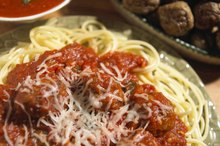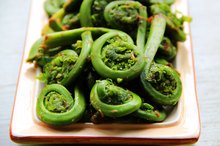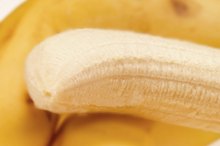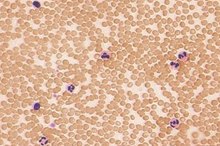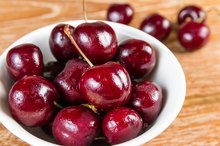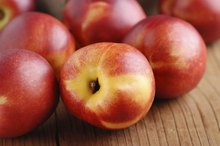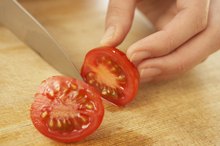What does fact checked mean?
At Healthfully, we strive to deliver objective content that is accurate and up-to-date. Our team periodically reviews articles in order to ensure content quality. The sources cited below consist of evidence from peer-reviewed journals, prominent medical organizations, academic associations, and government data.
- PubMed: Differential inhibition of oxidized LDL-induced apoptosis in human endothelial cells treated with different flavonoids
- PubMed: Differential inhibition of oxidized LDL-induced apoptosis in human endothelial cells treated with different flavonoids
- PubMed: Quantification of protodioscin and rutin in asparagus shoots by LC/MS and HPLC methods
- PubMed: Quantification of protodioscin and rutin in asparagus shoots by LC/MS and HPLC methods
- Science Direct: Rutin content in buckwheat (Fagopyrum esculentum Moench) food materials and products
The information contained on this site is for informational purposes only, and should not be used as a substitute for the advice of a professional health care provider. Please check with the appropriate physician regarding health questions and concerns. Although we strive to deliver accurate and up-to-date information, no guarantee to that effect is made.
Eating a nutritious diet plays a vital role in your health. Look at the foods you're eating and make sure you're getting enough rutin on a daily basis. Quercetin and rutinose combine to create rutin, a flavonoid and antioxidant that may protect your body from inflammation, blood circulation problems and cell damage caused by free radicals. There are a variety of foods you can eat to boost your intake of this important nutrient.
Buckwheat
Buckwheat tops the charts in terms of rutin content. Buckwheat serves as the richest source of rutin of all foods, according to the Phytochemicals website 4. Research published in a 2006 issue of "Food Chemistry" notes uncooked buckwheat leaf flour offers the highest level of rutin -- 675 mg in a 1.1 cup serving, making it ideal for enriching other foods to get the most health benefits from ingesting this nutrient. Other forms of buckwheat also contain rutin, although in lower levels. Uncooked buckwheat groats contain 230 mg of rutin per 1 kg, dark buckwheat flour has 218 mg per 1 kg and buckwheat noodles provide 78 mg. The article also notes buckwheat beer and vinegar may contain trace levels of rutin. The U.S. Department of Agriculture National Agricultural Library says buckwheat offers nutritional benefits other than rutin 1. A 1-cup serving of buckwheat contains 782 mg of potassium, 14 micrograms of selenium, 11.9 mg of niacin and 51 micrograms of folate.
Apples
The Health Benefits of Eating Cooked Tomato Products
Learn More
Maybe an apple a day doesn't keep the doctor away, but it may certainly help improve your health. The NutraSanus website reports apples, the peels in particular, serve as a rich source of rutin. Research published in the May 2005 issue of "The British Journal of Nutrition" indicates the rutin found in foods like apples can prevent your arteries from thickening as a result of cellular damage and decrease your risk of stroke and heart attacks. In addition to its high rutin content, apples offer additional nutritional benefits. The National Agricultural Library reports one medium apple provides you with 54 international units of vitamin A, 27 micrograms of beta-carotene, 4.6 mg of vitamin A and 3 micrograms of folate 1.
- Maybe an apple a day doesn't keep the doctor away, but it may certainly help improve your health.
- The NutraSanus website reports apples, the peels in particular, serve as a rich source of rutin.
Asparagus
Asparagus, a spring perennial vegetable, is rich in rutin. The Washington Asparagus website notes asparagus contains highly concentrated levels of this important nutrient. Research published in the October 2003 issue of the "Journal of Agricultural and Food Chemistry" notes the bottom portion of asparagus that often gets tossed in the trash as you're trimming it for cooking contains the highest levels of rutin and suggests using those stems as a nutritional source. Aside from rutin content, the National Agricultural Library notes a 1-cup serving of raw asparagus contains 32 mg of calcium, 271 mg of potassium, 70 micrograms of folate, 602 micrograms of beta-carotene, 55.7 micrograms of vitamin K and 1,013 international units of vitamin A 1.
- Asparagus, a spring perennial vegetable, is rich in rutin.
- Aside from rutin content, the National Agricultural Library notes a 1-cup serving of raw asparagus contains 32 mg of calcium, 271 mg of potassium, 70 micrograms of folate, 602 micrograms of beta-carotene, 55.7 micrograms of vitamin K and 1,013 international units of vitamin A 1.
Related Articles
References
- National Agricultural Library
- PubMed: Differential inhibition of oxidized LDL-induced apoptosis in human endothelial cells treated with different flavonoids
- PubMed: Quantification of protodioscin and rutin in asparagus shoots by LC/MS and HPLC methods
- Phytochemicals: Rutin
- Aziz Z, Tang WL, Chong NJ, Tho LY. A systematic review of the efficacy and tolerability of hydroxyethylrutosides for improvement of the signs and symptoms of chronic venous insufficiency. J Clin Pharm Ther. 2015;40(2):177-85. doi:10.1111/jcpt.12247
- Smyth RM, Aflaifel N, Bamigboye AA. Interventions for varicose veins and leg oedema in pregnancy. Cochrane Database Syst Rev. 2015;(10):CD001066. doi:10.1002/14651858.CD001066.pub3
- Morling JR, Yeoh SE, Kolbach DN. Rutosides for prevention of post-thrombotic syndrome. Cochrane Database Syst Rev. 2013;(4):CD005626. doi:10.1002/14651858.CD005626.pub2
- Anand David AV, Arulmoli R, Parasuraman S. Overviews of biological importance of quercetin: A bioactive flavonoid. Pharmacogn Rev. 2016;10(20):84–89.
- National Institute of Health. Dietary supplements: what you need to know. Updated January 15, 2020.
- Rutin. Natural Medicines Database. Professional Monograph. 3/15/2018
- Kauss T, Moynet D, Rambert J, et al. Rutoside decreases human macrophage-derived inflammatory mediators and improves clinical signs in adjuvant-induced arthritis. Arthritis Res Ther. 2008;10(1):R19.
Writer Bio
Nicki Wolf has been writing health and human interest articles since 1986. Her work has been published at various cooking and nutrition websites. Wolf has an extensive background in medical/nutrition writing and online content development in the nonprofit arena. She graduated with a Bachelor of Arts in English from Temple University.
